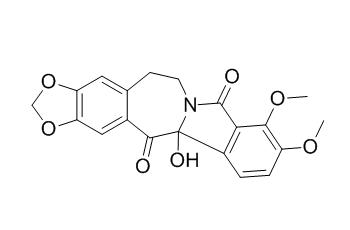Chilenine
Chilenine is a natural product from Hydrastis canadensis L.
Inquire / Order:
manager@chemfaces.com
Technical Inquiries:
service@chemfaces.com
Tel:
+86-27-84237783
Fax:
+86-27-84254680
Address:
1 Building, No. 83, CheCheng Rd., Wuhan Economic and Technological Development Zone, Wuhan, Hubei 430056, PRC
Providing storage is as stated on the product vial and the vial is kept tightly sealed, the product can be stored for up to
24 months(2-8C).
Wherever possible, you should prepare and use solutions on the same day. However, if you need to make up stock solutions in advance, we recommend that you store the solution as aliquots in tightly sealed vials at -20C. Generally, these will be useable for up to two weeks. Before use, and prior to opening the vial we recommend that you allow your product to equilibrate to room temperature for at least 1 hour.
Need more advice on solubility, usage and handling? Please email to: service@chemfaces.com
The packaging of the product may have turned upside down during transportation, resulting in the natural compounds adhering to the neck or cap of the vial. take the vial out of its packaging and gently shake to let the compounds fall to the bottom of the vial. for liquid products, centrifuge at 200-500 RPM to gather the liquid at the bottom of the vial. try to avoid loss or contamination during handling.
Food Res Int.2024, 197(Pt 1):115244.
Int J Mol Sci.2021, 22(16):8641.
Nutr Cancer.2024, 76(3):305-315.
J Agric Food Chem.2021, 69(46):14037-14047.
Molecules.2020, 25(7):1625.
Biomedicine & Pharmacotherapy2022, 153:113404.
International J of Green Pharmacy2019, 13(3)
Molecular & Cellular Toxicology 2024, 00444-8.
Front. Plant Sci.2022, 13:757852.
Molecules.2019, 24(4):E709
Related and Featured Products
Phytochem Lett. 2017 Jun;20:54-60.
Secondary Metabolites from the Leaves of the Medicinal Plant Goldenseal (Hydrastis canadensis).[Pubmed:
28736584]
The study presented herein constitutes an extensive investigation of constituents in Hydrastis canadensis L. (Ranunculaceae) leaves.
METHODS AND RESULTS:
It describes the isolation and identification of two previously unknown compounds, 3,4-dimethoxy-2-(methoxycarbonyl)benzoic acid (1) and 3,5,3'-trihydroxy-7,4'-dimethoxy-6,8-C-dimethyl-flavone (2), along with the known compounds (±)-Chilenine (3), (2R)-5,4'-dihydroxy-6-C-methyl-7-methoxy-flavanone (4), 5,4'-dihydroxy-6,8-di-C-methyl-7-methoxy-flavanone (5), noroxyhydrastinine (6), oxyhydrastinine (7) and 4',5'-dimethoxy-4-methyl-3'-oxo-(1,2,5,6-tetrahydro-4H-1,3-dioxolo-[4',5':4,5]-benzo[1,2-e]-1,2-oxazocin)-2-spiro-1'-phtalan (8). Compounds 3-8 have been reported from other sources, but this is the first report of their presence in H. canadensis extracts.
CONCLUSIONS:
A mass spectrometry based assay was employed to demonstrate bacterial efflux pump inhibitory activity against Staphylococcus aureus for 2, with an IC50 value of 180 ± 6 μM. This activity in addition to that of other bioactive compounds such as flavonoids and alkaloids, may explain the purported efficacy of H. canadensis for treatment of bacterial infections.
Finally, this report includes high mass accuracy fragmentation spectra for all compounds investigated herein which were uploaded into the Global Natural Products Social molecular networking library and can be used to facilitate their future identification in H. canadensis or other botanicals.



